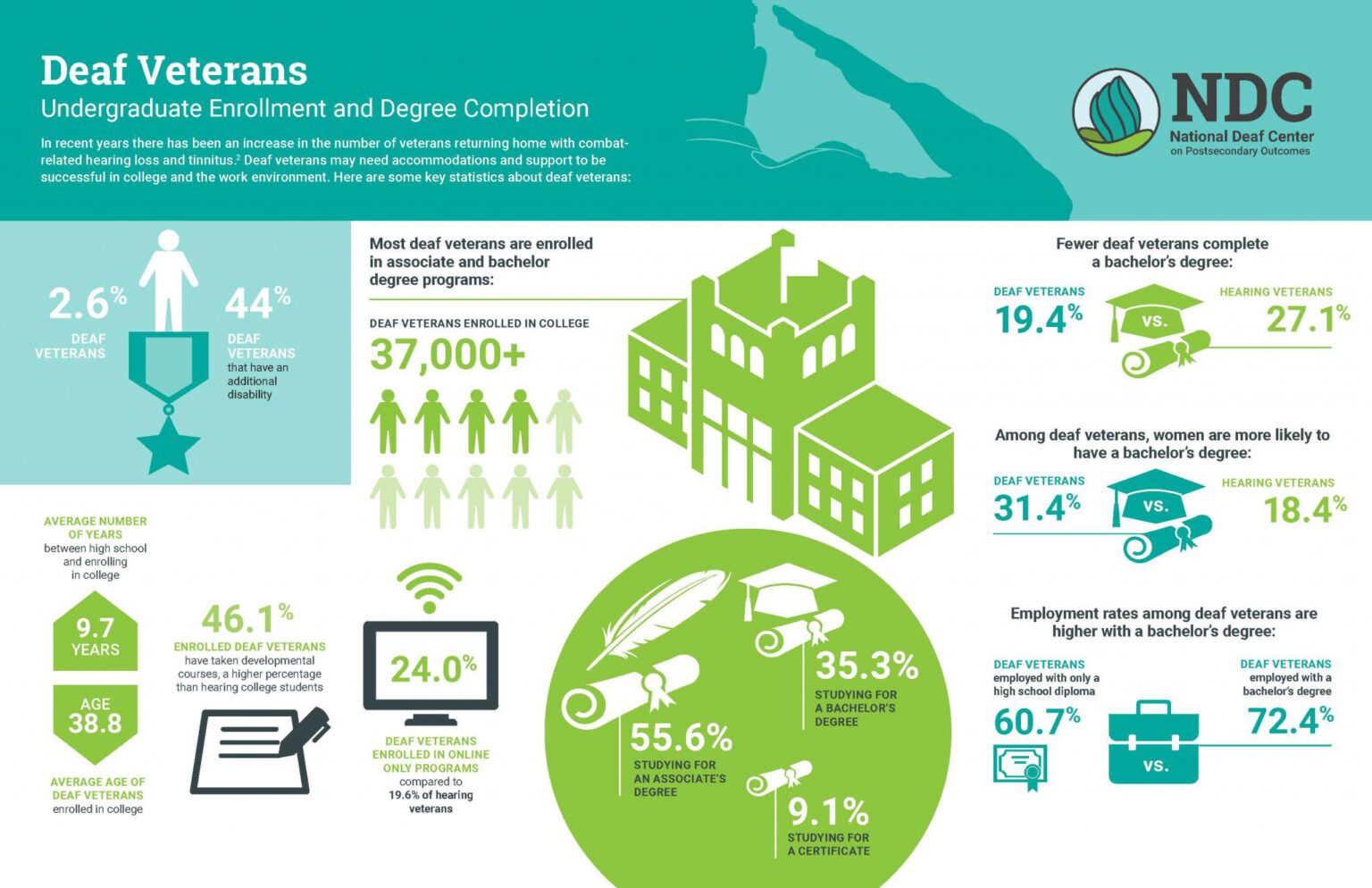Veteran’s Day reminds Americans to be grateful to every person who has worn a military uniform and fought for our safety and security. We also should be reminded of our responsibility to create opportunity for the more than 37,000 deaf veterans enrolled as students in colleges and universities throughout the United States.
A new report from the National Deaf Center on Postsecondary Outcomes finds that deaf veterans are not succeeding in college at the same rate as hearing veterans and are in need of more accommodations and support. This is happening at a time when more veterans than ever are experiencing hearing difficulties, which are the most prevalent disability they experience.
In the report, Deaf Veterans at College: Undergraduate Enrollment and Degree Completion, National Deaf Center researchers analyzed data from the U.S. Census Bureau, Veterans Benefits Administration, and U.S. Department of Education.
Among the 1.6 million veterans with a service-related disability, more than 67,000 American veterans (4.2%) have severe hearing difficulties, which may also include tinnitus. Of veterans in college, 2.6% are deaf; almost have of the deaf veterans (44%) also have additional disabilities. Of the 37,000 deaf veterans enrolled in college, they are older than typical college students, take more developmental courses, are more likely to be enrolled in online programs, and do not complete a bachelor’s degree at the same rate as hearing veterans. The report states:-
The average age of deaf veterans enrolled in college is 38.8 years old, with an average of 9.7 years between high school and enrolling in college
-
46.1% of enrolled deaf veterans have taken developmental courses, a higher percentage than hearing college students
-
Most deaf veterans are enrolled in associate and bachelor degree programs
-
55.6% studying for an associate’s degree
-
35.3% studying for a bachelor’s degree
-
9.1% studying for a certificate
-
24.0% of deaf veterans are enrolled in online-only programs, compared to 19.6% of hearing veterans
Enrollment is only one part of the battle deaf veterans face as college students. The National Deaf Center report shows degree completion significantly lags for deaf veterans. Just 19.4% of deaf veterans complete a bachelor’s degree, versus 27.1% for hearing veterans. However, women are more likely to have a bachelor’s degree, with 31.4% of female deaf veterans completing their degree, versus 18.4% of female hearing veterans.
“Deaf veterans on campus are facing barriers to success, which is a critical issue that colleges need to know about,” said Stephanie Cawthon, PhD, Director of the National Deaf Center and Professor at the University of Texas at Austin College of Education. “To become truly accessible, colleges and universities must provide accommodations that are as complex as the student body and create a culture in which access is about more than just accommodations.”
Recommendations for accommodations and support
To improve degree completion and assistance for this key student demographic, the National Deaf Center has recommendations for colleges and universities.Veterans who become deaf later in life and enroll in college will need to learn how to navigate unfamiliar college settings. Deaf veterans, like many deaf college students, often do not know about accommodations options, resources, and tools available to them. Colleges can support deaf veterans by:
-
Collaborating with dedicated veteran liaisons on campus
-
Reaching out to veteran advocacy and support groups
-
Sharing information about available accommodations, such as sign language interpreters, note-takers, captioning, and even visual fire alarms and other emergency preparedness measures
The disability services office can work closely with the campus veteran liaison to educate deaf veterans on the variety of accommodations available to them, as well as the process for requesting auxiliary aids and services. Some accommodations could even address their status as older students with other responsibilities, such as child care services.
Recommended resources for deaf veterans are available from the National Deaf Center (Accommodations 101), Heroes with Hearing Loss, Department of Defense Hearing Center of Excellence, Hearing Loss Association of America Veterans Chapter, Association of Late-Deafened Adults, and the National Association of the Deaf.
Recommended resources for campus and other professionals working with deaf veterans are available from the National Deaf Center (Disability Services Toolkit, Late-Deafened Individuals: Implications for Postsecondary Outcomes, Mental Health Care for Deaf Individuals), Student Veterans of America (Disability Services Liaison Toolkit and Liaison Program), and the Association of Higher Education and Disability’s Veterans Special Interest Group.
Other deaf students on campus
The National Deaf Center’s other recent report, Undergraduate Enrollment of Deaf Students in the United States, provides a comprehensive overview of the more than 220,000 deaf undergraduates who currently comprise 1.3% of enrollment in colleges and universities. Of all deaf undergraduate students, 17.1% are veterans. Other key findings include:
-
30.8% have learning difficulties
-
60.4% are first-generation students
-
51.8% are pursuing associate’s degrees
-
17.1% take their entire degree program online
-
Many deaf undergraduate students don’t pursue financial aid or vocational rehabilitation (VR) funding.
The bachelor’s degree completion gap between all deaf and hearing people is 15.2%, according to the National Deaf Center’s report Deaf People and Educational Attainment in the United States – 2019.
Veterans cope with non-military life Twenty three million veterans live in America. According to the Pew Research Center, 44% of those veterans report having a difficult time with the military-to-civilian life transition. While all returning veterans must adapt to their new normal, veterans with disabilities must take on the additional labor of learning about their disability and begin to navigate barriers to education and employment they have never experienced before. Efforts to improve veteran access to higher education have been largely successful. While the Post 9/11 G.I. Bill is a major motivating factor for veterans to pursue postsecondary education and, as a group, veterans are graduating at rates similar to nonveterans. However, as this new report from the National Deaf Center show, there are many student veterans that are falling through the cracks. Deaf veterans might not be the only ones; according to a 2017 report in The Atlantic, the percentage of veterans that graduated from community college ranges from 0% to 21%. Defining “deaf” Deaf veterans may use different identifying terms such as late-deafened, hearing impaired, hard of hearing, and more. The National Deaf Center uses the term “deaf” in an all-inclusive manner, to also include people who may identify as deaf, deafblind, or deafdisabled. The National Deaf Center recognizes that for many people, identity is fluid and can change over time or with setting. It has chosen to use one term, deaf, with the goal of recognizing experiences that are shared by all members of diverse communities while also honoring all differences — a concept explored in the video What Does Deaf Mean. The National Deaf Center’s mission is to close the substantial gaps in education and employment that exist for deaf people in the United States and its territories. It is a technical assistance and dissemination center housed at The University of Texas at Austin and federally funded by the Department of Education’s Office of Special Education Programs (OSEP) and Rehabilitation Services Administration (RSA) to provide evidence-based strategies at the local, state, and national levels.








